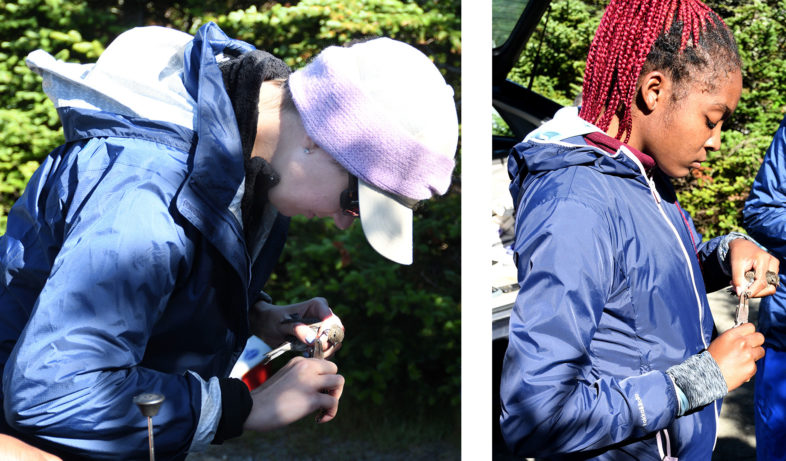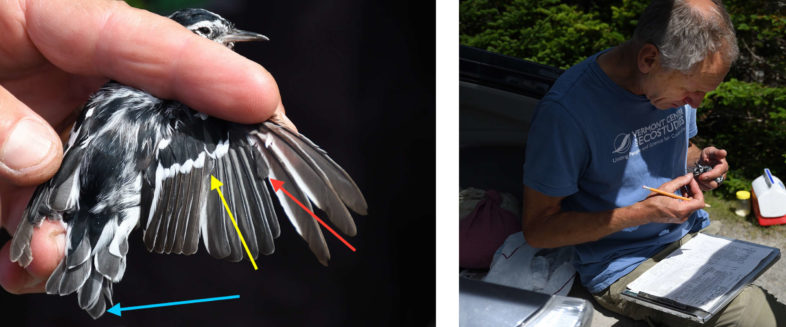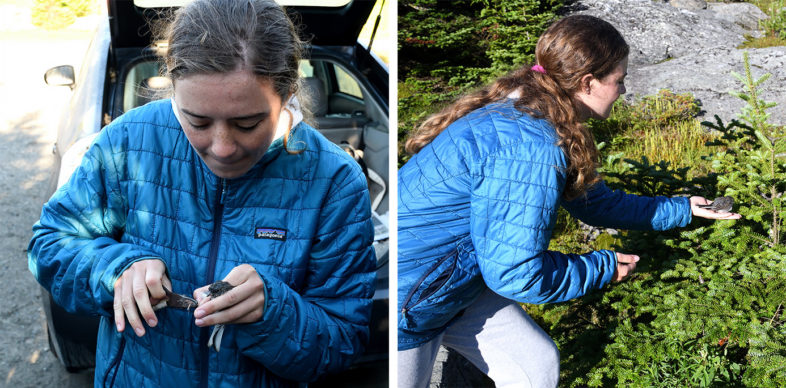
VCE summer interns Madison Sayers (left) and Latrice Hodges (right) banding juvenile Dark-eyed (Slate-colored) Juncos on Mt. Mansfield, 3 August 2022. © Michael Sargent
Noticeably shorter days, a near absence of bird song, heavily molting adults, and a paucity of mist net captures last week signaled seasonal changes on Mt. Mansfield. VCE’s final summer banding session on the ridgeline coincided with the calendar’s turn from July to August, and the winding down of our 31st field season. We expected the airwaves to be quiet and our captures relatively sparse, but visible and audible signs of avian activity were nearly absent. Common Ravens stole the show, with as many as 19 cavorting around the Nose, while our mist net production positively underwhelmed.
However, despite far more “down time” than usual at the VCE banding station, we managed to catch enough birds—29 in all—to keep spirits high. With near-ideal weather (mostly clear, calm, cool), we kept expecting a big net run, though it never materialized. Captures of Bicknell’s Thrush (BITH) were almost non-existent, with only a single juvenile that we had banded the previous week. My constant refrain of “Bring back a Tennessee Warbler!” went unfulfilled. Several adult birds were undergoing heavy post-breeding molt of their flight feathers and body, leading to some unscripted lessons in the finer points of molt ecology. Two individuals—a Blackpoll and Yellow-rumped (Myrtle) warbler—whose gender would have been unambiguously clear to us 2 weeks earlier had advanced so far in molt that they effectively sported non-breeding plumage; we were a bit chagrined to release both as “sex unknown”.

Left: an adult male Black-and-white Warbler in heavy wing molt. The 9 primaries molt sequentially and distally (away from the body), while replacement of the six secondaries begins later and proceeds proximally (towards the body). On this bird, note its three faded and worn outer primaries (#7–9), a barely detectable gap where primary #6 (fourth from outside) is missing, its 1/3-grown primary #5 (red arrow), and fresh and darker primaries #4 (nearly full length) through #1 (the innermost and first to molt). Only 5 of its six secondaries remain, and #1 is <1/3 grown (yellow arrow). The bird’s 12 tail feathers, which molt centrfugally (inside to out) on each side, and much more rapidly than the wings, are all between 1/3—1/2 full-grown (blue arrow). The entire molt will last 5-6 weeks, after which a fresh complement of flight feathers will carry this bird to its wintering grounds in the extreme southeastern U.S., Caribbean, Central or northern South America. Right: recording the progression of molt on a “molt card”, on which each individual flight feather is assigned a score from 0—5, according to its stage of growth (0=old, 5=new, fully-grown). © Michael Sargent
Our scant 2-day catch of 29 birds included:
Red-breasted Nuthatch — 1 juvenile
Winter Wren — 1 juvenile
Bicknell’s Thrush — 1 recapture of juvenile banded on 27 July
Swainson’s Thrush — 1 female with regressing brood patch
Dark-eyed (Slate-colored) Junco — 12 (9 juveniles)
White-throated Sparrow — 1 adult
Black-and-white Warbler — 1 male in heavy flight feather and body molt
Blackpoll Warbler — 1 adult in advanced molt that made sex determination impossible
Yellow-rumped (Myrtle) Warbler — 2 adults (1 male, 1 sex unknown) in advanced molt
Avian diversity and numbers may not have provided memorable highlights from our final 2022 summer banding session, but VCE’s mentoring of promising young conservation biologists did. Our inaugural Future Ecologists intern Latrice Hodges and our 2022 Alexander Dickey Conservation intern Madison Sayers demonstrated steady progress on mist net extractions, bird handling, and banding techniques. Both will wrap up their VCE internships in mid- August with a new suite of field skills, an immersive exposure to field biology, and a deeper understanding of career options. We wish them well. Kerry Brosnan, an Americorps member at North Branch Nature Center, eagerly gained hands-on experience, banding her very first bird in the process. As always, the human dimensions of VCE’s long-term work on Mansfield are every bit as rewarding as the conservation science we’ve now been practicing there for 31 years!

Emily Brosnan banding her first-ever bird, a Dark-eyed (Slate-colored) Junco, (left), releasing it moments later (right). © Michael Sargent
We’ll return to the ridgeline in mid-September for our final 2022 banding session, hoping to intercept streams of migrants, recover another BITH GPS tag or 3 (20 or bust…), and encounter a few intriguing surprises in our nets. You can be sure we’ll report on our findings.

Hi Chris
Fine explanation of songbird molting sequence and connection with migration. What are molting sequences of other species or groups of birds? Interested if Known for Loons. Connections with?…
Here in Poultney its juvenile city. From hummers to ronin to phoebes. sitting still on my porch< I have been examined by inquisitive young (niece?).
I too notice the morning silence here at low elevation. Timing set by day length?
Seeing also the start of pigment changes in the forest. Directed day length and/or night temperatures ( reaching 55 deg and lower) driven.
Only certainty is Change.
Regards Scott